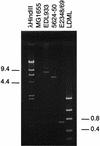Molecular evolution of a pathogenicity island from enterohemorrhagic Escherichia coli O157:H7
- PMID: 9673266
- PMCID: PMC108423
- DOI: 10.1128/IAI.66.8.3810-3817.1998
Molecular evolution of a pathogenicity island from enterohemorrhagic Escherichia coli O157:H7
Abstract
We report the complete 43,359-bp sequence of the locus of enterocyte effacement (LEE) from EDL933, an enterohemorrhagic Escherichia coli O157:H7 serovar originally isolated from contaminated hamburger implicated in an outbreak of hemorrhagic colitis. The locus was isolated from the EDL933 chromosome with a homologous-recombination-driven targeting vector. Recent completion of the LEE sequence from enteropathogenic E. coli (EPEC) E2348/69 afforded the opportunity for a comparative analysis of the entire pathogenicity island. We have identified a total of 54 open reading frames in the EDL933 LEE. Of these, 13 fall within a putative P4 family prophage designated 933L. The prophage is not present in E2348/69 but is found in a closely related EPEC O55:H7 serovar and other O157:H7 isolates. The remaining 41 genes are shared by the two complete LEEs, and we describe the nature and extent of variation among the two strains for each gene. The rate of divergence is heterogeneous along the locus. Most genes show greater than 95% identity between the two strains, but other genes vary more than expected for clonal divergence among E. coli strains. Several of these highly divergent genes encode proteins that are known to be involved in interactions with the host cell. This pattern suggests recombinational divergence coupled with natural selection and has implications for our understanding of the interaction of both pathogens with their host, for the emergence of O157:H7, and for the evolutionary history of pathogens in general.
Figures





References
-
- Beebakhee G, Louie M, Azavedo J D, Brunton J. Cloning and nucleotide sequence of the eae gene homologue from enterohemorrhagic Escherichia coli serotype O157:H7. FEMS Microbiol Lett. 1992;91:63–68. - PubMed
-
- Blattner F R, Plunkett III G, Bloch C A, Perna N T, Burland V, Riley M, Collado-Vides J, Glasner J D, Rode C K, Mayhew G, Gregor J, Davis N W, Kirkpatrick H A, Goeden M, Rose D, Mau B, Shao Y. The complete sequence of Escherichia coli K-12. Science. 1997;277:1453–1462. - PubMed
Publication types
MeSH terms
Substances
Associated data
- Actions
- Actions
- Actions
- Actions
- Actions
- Actions
- Actions
- Actions
Grants and funding
LinkOut - more resources
Full Text Sources
Other Literature Sources
Medical
Molecular Biology Databases

